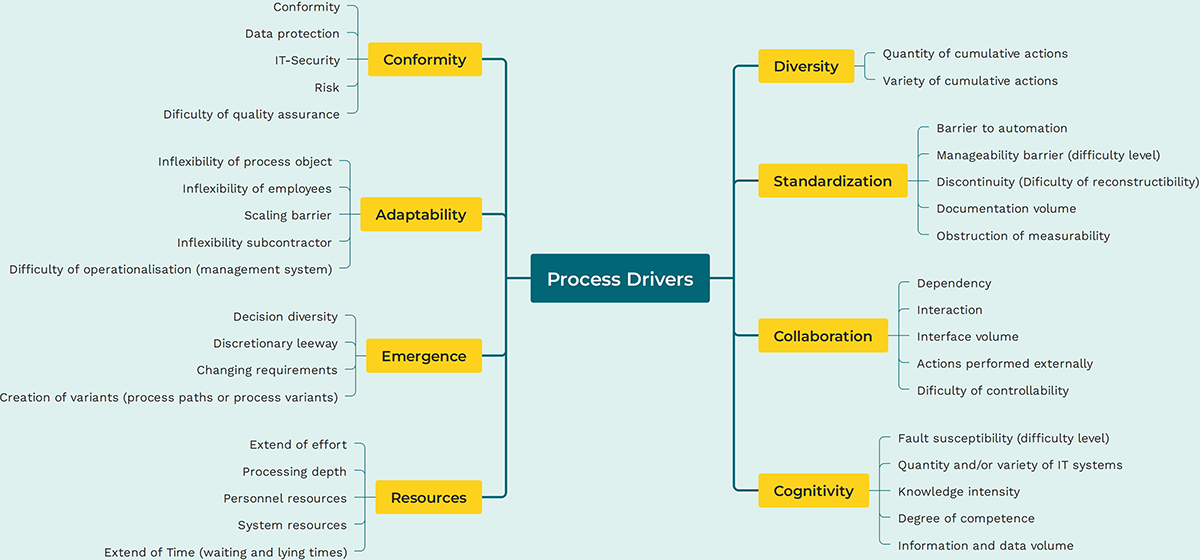Introduction:
In the era of digitalization, organizations need to adapt and develop resilience more than ever. The introduction of new technologies, the transformation of organizational structures and the dynamics of working environments open up new opportunities, but also confront organizations with previously unknown challenges. These developments, together with the increasing volume and diversity of data streams, are leading above all to increased complexity.
This article aims to provide organizations with comprehensive insights and decision support in dealing with process complexity.
Challenges of process complexity:
Complexity is often a significant barrier to process efficiency and makes it difficult to understand, control and optimize processes in organizations. Therefore, organizations actively strive to identify and eliminate unnecessary complexity.
Tony Robbins' famous quote "Complexity is the enemy of execution" sums up the fact that both societies and individuals in their various roles are increasingly overwhelmed when it comes to making decisions. Our economic system, which is geared towards growth, inevitably leads to more complexity in organizations.
Strategies for dealing with complexity:
Navigating complex systems that are increasingly dynamic, uncertain and globally networked is a huge challenge. Changing customer expectations in the areas of service quality, individualization and personalization, technologization and digitalization also present company leaders with huge tasks. According to a KPMG study, the greatest need for change lies in the areas of corporate structure and processes. Companies that best meet these change requirements and complexities will emerge as the winners.
How should organizations and affected stakeholders deal with this challenge and what tools and methods are available to master this level of complexity?
Let's take a systematic approach. Complexity is a term that is often used (sometimes indiscriminately) to describe situations that do not seem tangible, but rather entangled and inscrutable. It is often perceived as a subjective feeling rather than an objective state of an organization.
And not all subjectively perceived or objectively identified complex systems are harmful. In fact, the same complexity factors that can negatively impact a business can also create new opportunities for those companies willing to capitalize on the rapidly changing business environment.
For example, the number of customers you attract, the number of products or services you offer, the extent to which people in your organization collaborate and perform multiple tasks, the number of markets you are present in, and the number of people you employ can all increase complexity in your business while making it economically successful. In other words, well managed, this kind of complexity is more beneficial than detrimental.
This means that we are embedded in an ecosystem in which complexity is already predetermined by external circumstances (technologization, globalization, etc.). What is exciting, however, is how we deal with the individual complexity that the vast majority of us as employees are also confronted with. In other words, the complexity that is caused by poor processes, unclear role definitions or undefined responsibilities, for example.
Examples of such situations include:
initially efficient processes that become more bureaucratic over time
frustratingly long and time-consuming approval processes
countless meetings that take place because the process is unclear
unclear role definitions and process responsibilities that lead to silo initiatives being launched for the same problem or to no one tackling the problem at all
The classic approach is to start an optimization initiative and carry out the usual systematic steps. To summarize: Identify/select - Prioritize – design actual process and evaluate process key figures - Analyse and derive target process - Define target process - Implement and evaluate target process.
So far so good and learned by now. However, depending on the process, such initiatives can take on a considerable size and involve a great deal of effort (resources and time). Started with good intentions, you soon find yourself in a state of stagnation in which the project neither moves forward nor backwards. The truth is that up to 70% of transformation and optimization efforts come to nothing or fail, not least due to the prevailing complexity.
What if you knew in advance what you were getting into? If you knew how complex the process to be optimized is? If you could measure complexity objectively and make it manageable?
Eptacon has developed precisely the tools to free organizations from the spiral of complexity.
The approach:
With our method, Eptacon has developed the world's first IT-supported management approach that is specifically geared towards operational excellence and the optimisation of business processes. This approach integrates the entire improvement cycle into one model and uses a specially developed notation for recording and modelling performance processes - BPIN (Business Process Improvement Notation). BPIN is the world's first complexity-oriented modelling language that measures and evaluates process complexity and process performance in a standardised way.
BPIN is therefore not only a powerful modelling language, but also enables an actual process evaluation using 11 Process Performance Indicators (PPI). One of these is process complexity.




